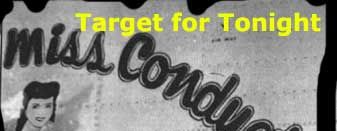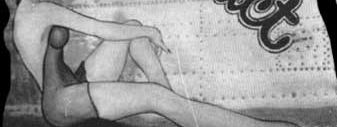





At the crew briefing, they are told the importance of the target, that there will be plenty of 'flak' (anti-aircraft fire) but that the target should be easy to find because it is bounded by railways and a river-canal network. Taking off at dusk, F for Freddie sets out on the long flight to southern Germany. The photography of the Wellington cutting through the night sky is impressive and powerfully evokes the sense of loneliness crews experienced on these long missions. Despite the darkness and distance, F for Freddie has little trouble in locating the target and, despite the heavy anti-aircraft fire, drops at least one bomb on the oil storage tanks: 'I got a bulls-eye with that one', shouts the bomb-aimer looking back at the fiery explosion. However, pulling away from the target, the Wellington is hit by flak, and the radio operator wounded. With the radio out of action, and a damaged engine, F for Freddie begins the difficult return flight to base. The first planes from the squadron return at 3 am, but as there is no sign of Freddie, the operations room staff gradually give up hope, believing that the aircraft must have been shot down. Meanwhile, delayed by the damaged engine, the Wellington is nearing the airfield, the pilot offers his crew the choice: bale out of the base or stick with the machine while the pilot attempts a landing with the damaged engine. Unanimously the crew elects to stay with the plane, even though a thick fog is now beginning to cover the airfield. Eventually, with the help of the control tower staff and extra landing lights, the aircraft lands safely. At the de-briefing the crew explain that their first bombs were dropped short of the target but that the last one started a major fire - 'black smoke, dullish red flames', they explain. 'Sounds all right' confirms the intelligence officer, and the attack is judged to be successful. The crew leaves the briefing room on their way to a well-earned breakfast.

Target for Tonight is a detailed and revealing picture of the work of Bomber Command, and powerfully brought home to audiences exactly how the RAF was striking at the enemy and the understated, almost casual courage of the young airmen who flew these nightly missions. But it was equally powerful propaganda for a democracy at war. The film makes considerable play of the team effort involved in preparing the raid, from the intelligence officers at the Air Ministry who plan the raid, to meteorologists and the ground crews who prepare the aircraft for its mission - all are essential for the success of the mission. The crew of F for Freddie suggests another metaphor for democracy. Watt ensured that the crew he selected was representative of the allied cause - an English pilot, a Scotsman, an Australian, a Canadian and two representatives of English regions.





